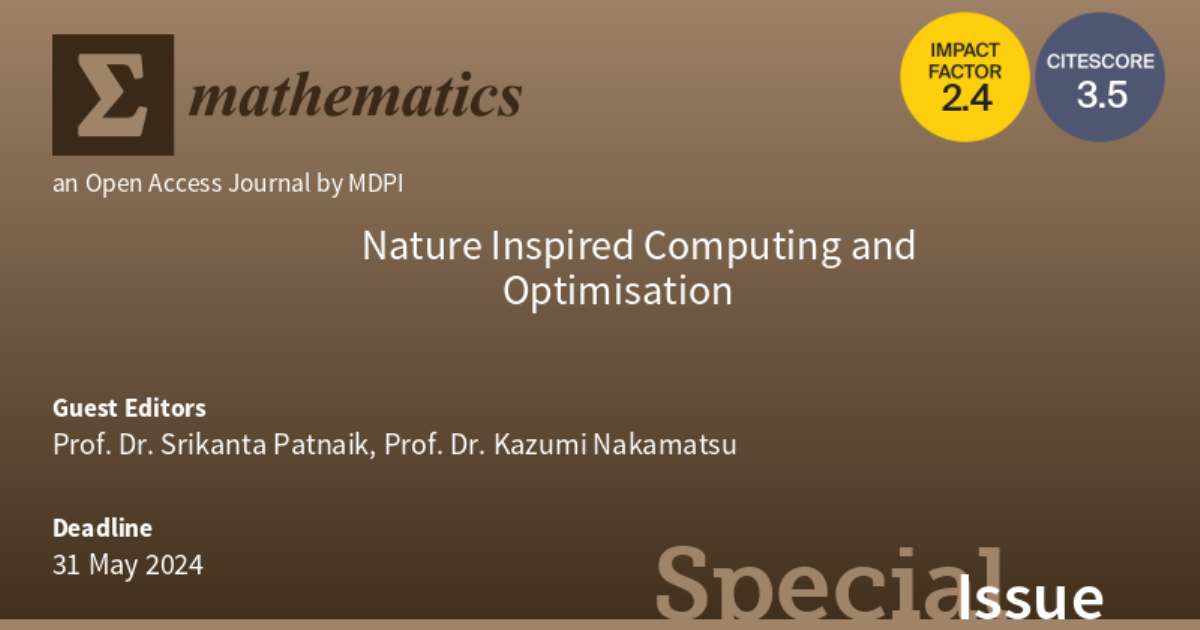Nature Inspired Computing and Optimisation
A special issue of Mathematics (ISSN 2227-7390). This special issue belongs to the section "Computational and Applied Mathematics".
Deadline for manuscript submissions: 31 May 2024 | Viewed by 13649

Special Issue Editors
Interests: artificial intelligence; computational intelligence; soft computing applications; re-engineering
Special Issues, Collections and Topics in MDPI journals
Special Issue Information
Dear Colleagues,
Nature-inspired computing is an interdisciplinary field and a branch of artificial intelligence that employs processes, which is involved in evolution of living beings, biology and nature for solving complex problems. Artificial Intelligence covers higher level processes like problem solving, reasoning, making inferences in abstract and virtual worlds that consist of precisely defined states and operations in closed systems unlike real world. During the last decade, due to the convergence of bio, nano and information technology, an appreciable amount of research has been done on sensors and actuators, which leads to the design of many autonomous agents and robots and subsequently the development of Multi Agent Systems (MAS) for real world applications. Usually real-time systems are complex, inconsistent, uncertain and imprecise, which is difficult to handle using traditional methods. But inspiring nature has leaded to finding clues for solution of unsolved problems of this kind. Nature-inspired computing has been existing since last many decades in the form of bio-inspired computing which includes small number of tools like evolutionary computing, neural networks, particle swarm optimization, and ant colony optimization. Gradually other forms of intelligence are added to nature-inspired computing such as artificial bee colony optimization, cuckoo search, firefly algorithm, bacteria foraging optimization algorithm, intelligent water drop optimization, gravitational search, and harmony search along with many more. These computational techniques use biological or evolutionary processes as main component in the efficient design and implementation of the artificial intelligent algorithms.Nature-inspired computing can be applied to a variety of problems, ranging from engineering and scientific research to manufacturing industry and business as they provide robust and flexible solutions along with learning and adaptability as compared to traditional optimization techniques. It can be applied to solve optimization issues in any domain and may be unified as Nature-inspired computing and optimization (NICO). While studying the nature, researchers found a number of cases from ant, bee, flock of birds, frog, cuckoo, firefly, bat, crocodile etc., which can be modelled for real-world problem. Looking at the emergence of bio, info and nano technology we are confident that the field of the nature-inspired computing and optimization can solve many complex real world problems
Prof. Dr. Srikanta Patnaik
Prof. Dr. Kazumi Nakamatsu
Guest Editors
Manuscript Submission Information
Manuscripts should be submitted online at www.mdpi.com by registering and logging in to this website. Once you are registered, click here to go to the submission form. Manuscripts can be submitted until the deadline. All submissions that pass pre-check are peer-reviewed. Accepted papers will be published continuously in the journal (as soon as accepted) and will be listed together on the special issue website. Research articles, review articles as well as short communications are invited. For planned papers, a title and short abstract (about 100 words) can be sent to the Editorial Office for announcement on this website.
Submitted manuscripts should not have been published previously, nor be under consideration for publication elsewhere (except conference proceedings papers). All manuscripts are thoroughly refereed through a single-blind peer-review process. A guide for authors and other relevant information for submission of manuscripts is available on the Instructions for Authors page. Mathematics is an international peer-reviewed open access semimonthly journal published by MDPI.
Please visit the Instructions for Authors page before submitting a manuscript. The Article Processing Charge (APC) for publication in this open access journal is 2600 CHF (Swiss Francs). Submitted papers should be well formatted and use good English. Authors may use MDPI's English editing service prior to publication or during author revisions.
Keywords
- ant colony optimization (ACO)
- bee colony optimization
- honey-bee mating dance
- bacterial foraging optimization
- particle swarm optimization
- shuffled leaping-frog algorithm,
- artificial immune systems
- memetic algorithms (MA)
- simulated annealing (SA)
- intelligent water drops
- gravitational search
- river formation dynamics
- charged system search
- stochastic diffusion search
- threshold acceptance (TA)
- tabu search (TS)
- variable neighborhood search (VNS)
- iterative local search (ILS)
- guided local search (GLS)
- genetic algorithms (GA)
- scatter search (SS)
- greedy randomized adaptive search procedure (GRASP)
- the harmony method
- cuckoo search
- firefly algorithm
- bat algorithm
- flower pollination algorithm
- ruin and recreate
- the great deluge algorithm
- human brain function inspired algorithms





